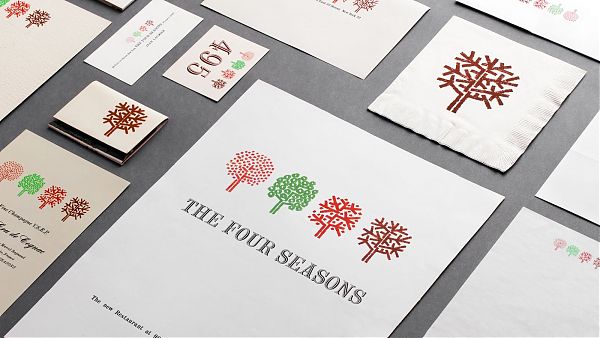Farewell to the Four Seasons

Photograph by Sharon Radisch.
In January 1960, my grandfather, a graphic designer and special assistant for Dartmouth’s Hopkins Center, wrote to Restaurant Associates, requesting samples of the printed matter created by Emil Antonucci for their recently-opened Four Seasons restaurant at the Seagram Building.
Cleaning out his studio more than 50 years later, my mother discovered the long envelope RA sent back, chock-full of graphic goodies featuring Antonucci’s elegant hand-drawn line of trees: round pink buds for spring, fat green leaves for summer, spiky red boughs for fall, and stark brown branches for winter. Below, in Chisel capitals, THE FOUR SEASONS, like the stone plaza beneath a line of Dan Kiley saplings.
Because my grandfather wrote to them in winter, the oversize lunch and dinner menus inside feature the winter tree, printed hand-size and looking as if it was painted on the rice-paper cover with a broad, flat Japanese brush. Anontucci’s graphics combine the rough with the smooth, serving, as the potted plants and the Richard Lippold sculpture and Fortuny-clad powder room did, to soften the hard edges of Philip Johnson and William Pahlmann’s modernist interior.
I mention the matchbooks and coat check, menus and place card, stationery and cocktail napkins not to tell you that my career as design historian often feels like a research project into the lives my grandparents lived, but to point out that this ephemera was seen as worth writing away for in 1960, and seen as worth saving for 50 years. And it is perhaps the least famous element of the Four Seasons restaurant design. What will be sold in Wright’s July 26 auction are many more famous items, from custom brass-topped Eero Saarinen tables to the silver-plated footed bread bowls designed by L. Garth and Ada Louise Huxtable, each as considered as Antonucci’s trees.
On X
Follow @LangeAlexandraOn Instagram
Featured articles
CityLab
New York Times
New Angle: Voice
Getting Curious with Jonathan Van Ness